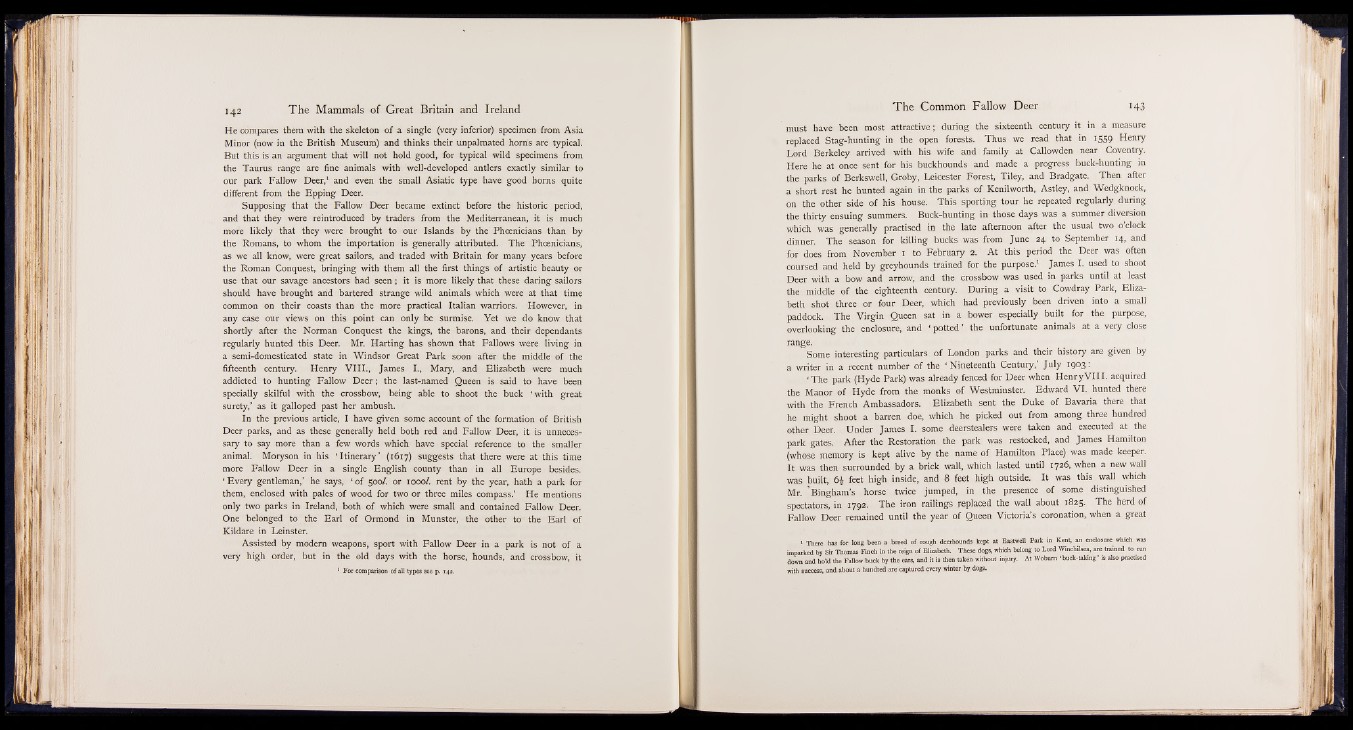
He compares them with the skeleton of a single (very inferior) specimen from Asia
Minor (now in the British Museum) and thinks their unpalmated horns are typical.
But this is an argument that will not hold good, for typical wild specimens from
the Taurus range are fine animals with well-developed antlers exactly similar to
our park Fallow Deer,1 and even the small Asiatic type have good horns quite
different from the Epping Deer.
Supposing that the Fallow Deer became extinct before the historic period,
and that they were reintroduced by traders from the Mediterranean, it is much
more likely that they were brought to our Islands by the Phoenicians than by
the Romans, to whom the importation is generally attributed. The Phoenicians;
as we all know, were great sailors, and traded with Britain for many years before
the Roman Conquest, bringing with them all the first things of artistic beauty or
use that our savage ancestors had seen; it is more likely that these daring sailors
should have brought arid bartered strange wild animals which were at that time
common on their coasts than the more practical Italian warriors. However, in
any case our views on this point can only be surmise. Yet we do know that
shortly after the Norman Conquest the kings, the barons, and their dependants
regularly hunted this Deer. Mr. Harting has shown that Fallows were living in
a semi-domesticated state in Windsor Great Park soon after the middle of the
fifteenth century. Henry VIII., James I., Mary, and Elizabeth were much
addicted to hunting Fallow Deer; the last-named Queen is said to have been
specially skilful with the crossbow, being able to shoot the buck ‘ with great
surety,’ as it galloped past her ambush.
In the previous article, I have given some account of the formation of British
Deer parks, and as these generally held both red and Fallow Deer, it is unnecessary
to say more than a few words which have special reference to the smaller
animal. Moryson in his ‘ Itinerary’ (1617) suggests that there were at this time
more Fallow Deer in a single English county than in all Europe besides.
‘ Every gentleman,’ he says, ‘ of 500/. or 10001. rent by the year, hath a park for
them, enclosed with pales of wood for two or three miles compass.’ He mentions
only two parks in Ireland, both of which were small and contained Fallow Deer.
One belonged to the Earl of Ormond in Munster, the other to the Earl of
Kildare in Leinster.
Assisted by modern weapons, sport with Fallow Deer in a park is not of a
very high order, but in the old days with the horse, hounds, and crossbow, it
1 For comparison of all types see p. 142.
must have been most attractive; during the sixteenth century i t in a measure
replaced Stag-hunting in the open forests. Thus we read that in 1559 Henry
Lord Berkeley arrived with his wife and family at Callowden near Coventry.
Here he at once sent for his buckhounds and made progress buck-hunting in
the parks of Berkswell, Groby, Leicester Forest, Tiley, and Bradgate. Then after
a short rest he hunted again in the parks of Kenilworth, Astley, and Wedgknock,
on the other side of his house. This sporting tour he repeated regularly during
the thirty ensuing summers. Buck-hunting in those days was a summer diversion
which was generally practised in the late afternoon after the usual two o’clock
dinner. The season for killing bucks was from June 24 to September 14, and
for does from November 1 tb February 2. At this period the Deer was often
coursed and held by greyhounds trained for the purpose.1 James I. used to shoot
Deer with a bow and arrow, and the crossbow was used in parks until at least
the middle of the eighteenth century. During a visit to Cowdray Park, Elizabeth
shot three or: four Deer, which had previously been driven into a small
paddock. The Virgin Queen sat in a bower especially built for the purpose,
overlooking the enclosure, and ‘ potted ’ the unfortunate animals at a very close
range,
Some interesting particulars of London parks and their history are given by
a writer in a recent number of the ‘ Nineteenth Century,’ July 1903:
‘ The park (Hyde Park) was already fenced for Deer when HenryVIII. acquired
the Manor of Hyde from the monks of Westminster. Edward VI, hunted there
with the French Ambassadors. Elizabeth sent the Duke of Bavaria there that
he might shoot a barren doe, which he picked out from among three hundred
Other Deer. Under James I. some deerstealers were taken and executed at the
park gates. After the Restoration the park wns restocked, and James Hamilton
(whose: memory is kept alive by the name of Hamilton Place) was made keeper.
It was then surrounded by a brick wail, which lasted until 1726, when a new wall
was built, 6J feet high inside, and 8 feet high outside. It was this wall which
Mr. ’ Bingham’s horse twice jumped, in the presence of some distinguished
spectators, in 1792. The iron railings replaced the wall about 1825. The herd of
Fallow Deer remained until the year of Queen Victoria’s coronation, when a great
1 There has for long been a breed of rough deerhounds kept at Eastwell Park in Kent, an enclosure which was
imparked by Sir Thomas Finch in the reign of Elizabeth. These dogs, which belong to Lord Winchilsea, are trained to run
down and hold the Fallow buck by the ears, and it is then taken without injury. At Woburn ‘ buck-taking ’ is also practised
with success, and about a hundred are captured every winter by dogs.